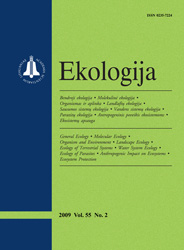 ISSN 0235-7224 ISSN 2029-0586 (online) |
2010 m. Nr. 1-2 Plankton food web structure during cyanobacteria bloom
in the highly eutrophic Lake Gineitiškės
Plankton community structure (algae, bacteria, heterotrophic flagellates, ciliates, rotifers, crustaceans) was studied in the highly eutrophic Lake Gineitiškės during June–October 2004. In the warm vegetation period, cyanobacteria (especially Microcystis and Anabaena) dominated in phytoplankton both by the abundance (87–98%) and biomass (55–91%), while in the early summer a considerable part of the phytoplankton biomass (37%) was made by green algae (Pediastrum) too. Among metazoan plankton, rotifers were dominant in density throughout the whole study period, but cladocerans prevailed in the metazoan plankton biomass from June to August (in July also rotifers), while copepods and rotifers formed zooplankton biomass in October. The zooplankton biomass (1120.45 μg C l–1), mainly ciliates and crustaceans, was highest in early summer and positively correlated with the highest amount of edible algae, whereas the abundance and biomass of cladocerans diminished 2–20 and of copepods 2–4 times during the mass development of cyanobacteria. Bacteria had the dominant role in the microbial loop, while heterotrophic flagellates’ density was low during the study period. The proportion of different groups in the total heterotrophic organisms’ biomass showed that herbivorous crustaceans did not control directly a larger part of phytoplankton biomass under cyanobacteria bloom conditions, and in this period the role of bacteria and rotifers in the organic carbon pool increases. Keywords: phytoplankton, microbial loop, metazoan plankton, highly eutrophic lake |
Issues:
2011 - Vol.57 No. 1, No. 2 2010 - Vol.56 No. 1-2, No. 3-4 2009 - Vol.55 No. 1, No. 2, No. 3-4 2008 - Vol.54 No. 1, No. 2, No. 3, No. 4 2007 - Vol.53 No. 1, No. 2, No. 2.priedas, No. 3, No. 4 2006 No. 1, No. 2, No. 3, No. 4 2005 No. 1, No. 2, No. 3, No. 4 2004 No. 1, No. 2, No. 3, No. 4 2003 No. 1, No. 2, No. 3, No. 4 2002 No. 1, No. 2, No. 3, No. 4 2001 No. 1, No. 2, No. 3, No. 4 |